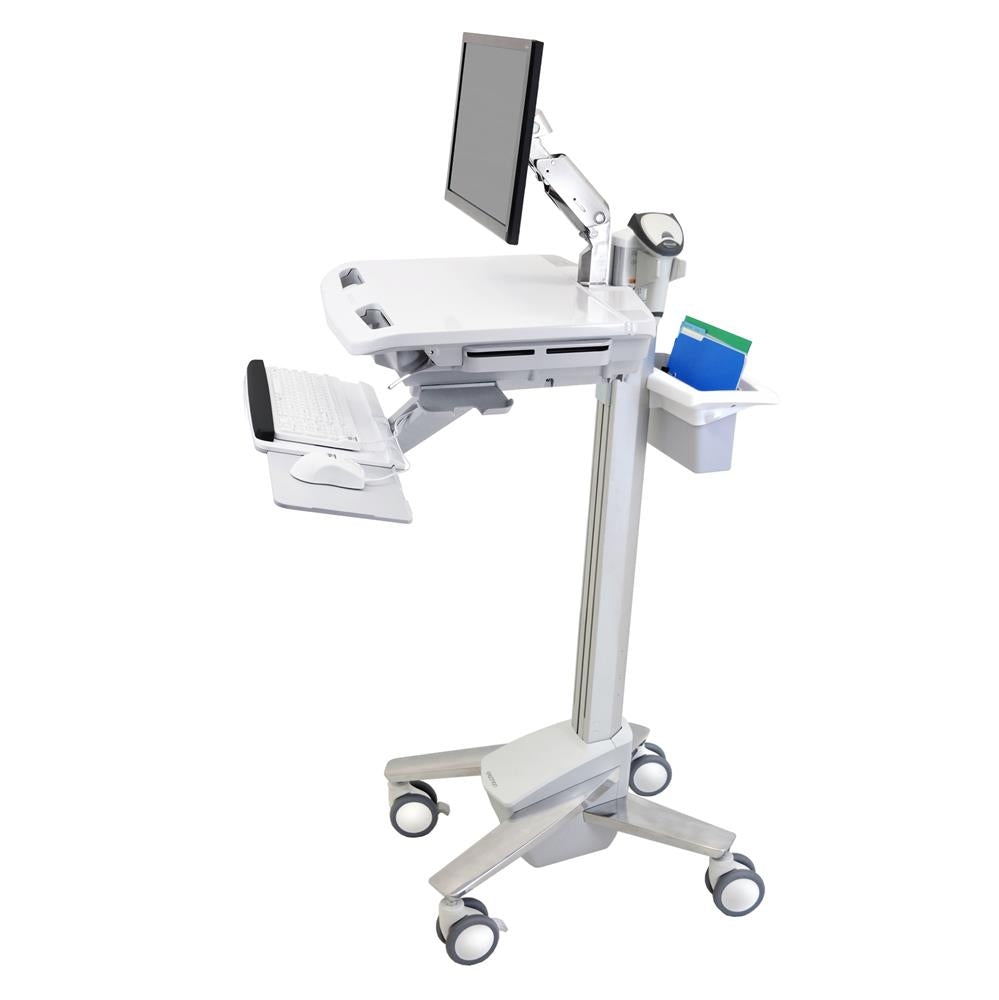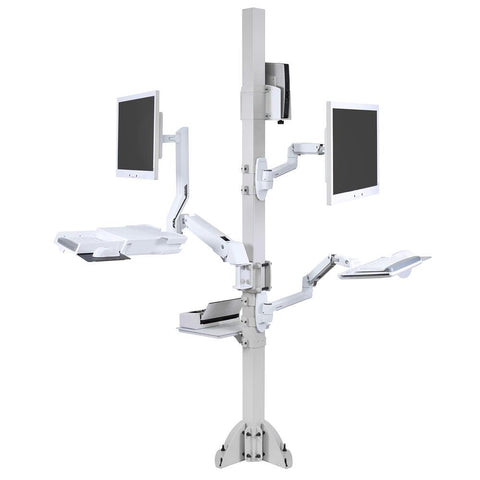This article aims to do two things:
1/ Identify some of the questions, issues and challenges associated with implementing an intraoral dental scanning system.
2/ Offer several different cart based mounting solutions. Our different mounting solutions are fully costed and incorporate industry leading Ergotron equipment.
Lucinda Technology Solutions supplies the equipment that puts your computers, monitors, scanners and other accessories where they will make you productive.
We do not pretend to be clinical or application experts. That expertise belongs to you the clinician and to the sales / support team of the digital dentistry package you select.
What we do and do very well is offer practical, cost effective and customized equipment solutions. Solutions for putting your IT equipment where you want it when you need it .. and getting it out of the way when it's not in use.
THE OPPORTUNITY
There's no denying it. Intraoral dental scanning systems have brought digital dentistry to an exciting new level. The concept is great, the productivity increase is measurable and the results speak for themselves.
We at Lucinda Technology Solutions are proud to play a part in assisting the roll-out of this exciting and ever advancing technology.
THE CHALLENGE
Dental scanning technology comes with many options. The challenge is to find a solution that is economical, space saving, productive and the best fit for your practice.
The first question to answer is "do I want a proprietary system solution or an 'open source' system? "
Proprietary solutions often include an integrated CPU, monitor, scanner and power supply on a moveable cart.
By contrast, open source systems offer more choice in how a dental scanning system is assembled and deployed.
Each choice - proprietary or open source has pros and cons.
PROPRIETARY SOLUTIONS
PRO:
- TURNKEY INTEGRATED SOLUTION
- ONE SOURCE MANUFACTURER'S SUPPORT
CON:
- TEND TO BE EXPENSIVE
- CLOSED 'ECOSYSTEM' MAY LIMIT INTERFACE WITH OTHER MANUFACTURER'S EQUIPMENT
- IMPLEMENTATION OF FUTURE DIGITAL DENTISTRY FEATURES MAY BE LIMITED BY THE MANUFACTURER'S DEVELOPMENT TIMETABLE
- SINGLE USE APPLICATION, MAY BE DIFFICULT TO MULTI-TASK WITH OTHER APPLICATIONS
OPEN SOURCE SOLUTIONS
PRO:
- PRACTITIONER SELECTS OPTIONS (SOFTWARE, MONITOR SIZE & TYPE, CPU OR LAPTOP ETC.)
- WORKSTATION CAN BE USED FOR OTHER APPLICATIONS AS WELL
- SOLUTION IS 'FUTURE PROOFED' - NEW OR REPLACEMENT COMPONENTS CAN BE ADDED AS TECHNOLOGY CHANGES
CON:
- REQUIRES INDEPENDENT PRE-PURCHASE RESEARCH
- SOLUTION MAY REQUIRE SEVERAL VENDORS
The focus of this article is on open-source solutions. Proprietary, 'all-in-one' systems generally come with their own integrated mounting solution.
DESIGNING YOUR IMPLEMENTATION
Configuring the ideal mobile solution to house your intraoral scanning system is straightforward if you take the time to answer some key questions.
1/ How many times a day will the system be used and how long will a typical use session last? Will it be shared by other associates?
This information will help determine the best battery power option (more on this later).
2/ Do you plan to share chairside images with patients as an aid to developing a treatment plan?
If so, a larger monitor and possibly an articulating arm will be a good choice.
If you don't need to share images, a laptop only solution may be sufficient.
3/ Do you plan to use a laptop or a small footprint desktop computer to run the scanning system software?
If the software will run on a commercial grade laptop, this is usually a better choice because of its smaller size and lower power consumption.
A laptop can also be used to 'drive' a conventional monitor.
4/ What IT equipment and accessories need to be accommodated on the mobile system?
Most systems includes a CPU (laptop or small footprint desktop computer), LCD monitor, mouse, keyboard, scanner and possibly other accessories.
5/ What needs to be plugged in ?
A typical system will require 2 wall type AC power outlets- one for the LCD monitor and one for the computer. In addition the accessories (scanner, mouse, keyboard) will each require access to a USB-C port.
6/ How much power measured in Watts do the main system components (laptop or desktop computer and LCD monitor) consume?
This technical information is available from manufacturer's websites but to give an idea, typical LCD monitors use 25 watts and the ThinkPad laptop used to compose this article uses an average of 75 watts. Total system requirement: 100 watts.
Battery systems are rated in Watt/Hours so for example a 300 Watt/Hour battery system could theoretically provide 3 hours of power for our example configuration. In reality there may be as much as 15% loss in the conversion from battery DC to output AC so a more reliable estimate is a little more than 2.5 hours.
POWERING YOUR MOBILE SYSTEM
LCD monitors and computers require AC power to operate. No way around it! The challenge with mobile computing systems is how to reduce the amount of time spent tethered by a cable or cables to an AC, wall power outlet.
There are 4 options:
OPTION #1
Keep the Computer and LCD Monitor plugged into the wall while in use using long extension cords. This allows for a limited amount of cart mobility but requires unplugging the cables to move the cart out of the work area.
This may be doable but is not convenient and is not a recommended solution because of the cable tripping hazard and inconvenience of connecting and disconnecting cables before every move.
OPTION #2
For systems that use a laptop only (no LCD monitor), the laptop's battery power may be sufficient to run the scanning software for several use sessions but battery power must be monitored carefully.
Different scanner and laptop combinations will have varying power requirements which can only be determined through actual use.
OPTION #3
Invest in a purpose built lithium or LiFe battery system that guarantees several hours of continuous service. These systems can include 'hot - swappable' spare batteries and are designed for heavy, continuous usage in hospital and industrial settings.
We can supply these systems: however they are an expensive option for intermittent, relatively light usage applications like intraoral scanning.
Contact us to learn more.
OPTION #4 -Recommended
Our recommended power solution for light use applications like intraoral scanning is a small, portable power system device.
These systems combine a battery, an inverter (to convert the batteries DC power to AC), 2 AC plug ins and several USB ports. When not in use the device is plugged into an AC wall socket to recharge the battery.
An example product is the Energizer Arc 3 , 300 Watt/Hour powerstation.
This product and others like it are relatively inexpensive, lightweight and readily available in Canada.
If the application requires more battery capacity select the larger model Energizer Arc 5 , 537 Watt/Hour powerstation.
CHOOSING YOUR MOBILE SOLUTION
A key decision in selecting the best mobile solution for your practice is based on how you prefer to interact with your patients. If you like to discuss treatment plans and show results in real time, a cart with an LCD monitor is a better choice for sharing visual information.
Conversely, if sharing visual information is not a big requirement, a laptop cart will suffice.
All of the cart configurations we offer include these features and more:
- 27" of sit / stand height adjustability
- scanner holder bracket
- lockable CPU cabinet under worksurface
- built-in four port USB hub
- negative tilt keyboard tray
FEATURED DENTAL SCAN CART CONFIGURATIONS
LCD Cart with Arm
This is the best choice for chairside interaction between patient and clinician. The monitor arm tilts, pans, turns left, right, up and down to accommodate everybody viewing the screen.

LCD Cart with Pivot
This model also facilitates patient and clinician chairside interaction. The monitor pivot offers a limited degree of tilt, pan and lift for shared screen viewing.

Laptop Cart
This model allows for some patient and clinician chairside interaction. The viewing angle is fixed so the cart needs to be turned in order to facilitate patient viewing.

WE'RE HERE TO HELP
Digital dentistry procedures like intraoral scanning are opening exciting new possibilities for clinicians and patients.
One of the challenges is getting the technology to the point of care when it's needed and out of the way when it's not. That's where Lucinda Technology Solutions can help.
Please don't hesitate to contact us with any questions you may have about computer cart solutions to your technology implementations!












